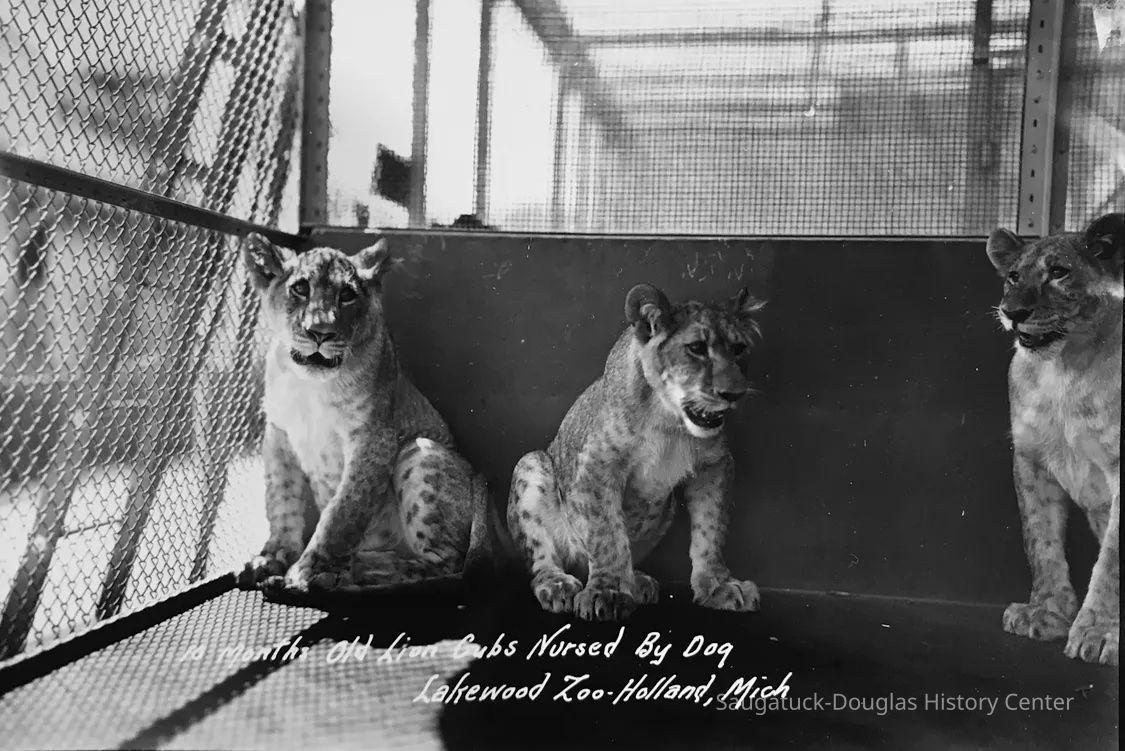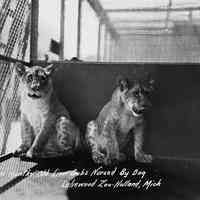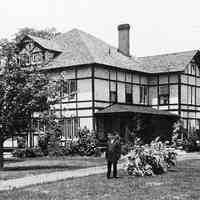Getz Zoo and Lakewood Farm

2023.50.73
George F. Getz, a wealthy industrialist, founded the Lakewood Farm, north of Holland in 1910, turning a sterile plot of lakefront property into fertile gardens and orchards. In the 1920s he began his zoo with camels brought back from the Holy Lands. By 1933 most of the menagerie had been sent to area zoos, and Getz died in 1938. The land has since been subdivided. A group of Allegan County sportsmen purchased the Getz deer herd and the animals were the start of restocking program in the Allegan Forest.
SDHS NL Inserts
Winthers, Sally
Digital data in CatalogIt
DeSoto, Helen (Gage)
This information was OCR text scanned from SDHS newsletter supplements. Binders of original paper copies are in the SDHC reference library.
Lakewood Farm, also known as the Getz Zoo, Getz Farm, or Lakewood Zoo, is a house and outbuildings located at 264 Lakeshore Avenue in Holland, Michigan. The property was placed on the National Register of Historic Places in 2020. In 1902, forty-two-year-old Ida Florence Fay of Chicago purchased 71 acres along Lake Michigan, which included this property. She constructed a mansion overlooking the lake in 1903, and began planting fruit trees. She named the property the "Lakewood Farm." She lived at the farm until 1910, when she listed it for sale.[2] In August 1910, George Fulmer Getz, the owner of Chicago-based Globe Coal Company, purchased Lakewood Farm and the mansion built by Ida Fay. Getz was a self-made millionaire, and he and his wife were looking for a location to build a summer home. However, they chose the Lakewood property with its already extant house.[2] Contemporary newspaper articles during George Getz's lifetime, lookback articles in the decades following his death and a self-published book by Holland author Donald van Reeken all note that George Getz built Lakewood from barren wasteland. Research for the nomination, conducted by Valerie van Heest of Lafferty van Heest and Associates in Holland discovered the inaccuracy. Weeks after purchasing Lakewood Farm in 1910, Getz's wife Susan died of complications from childbirth. Getz adjusted to life as a single father, and his plans for the Lakewood property shifted. He purchased additional adjacent property in 1911, and worked to develop the estate into a working fruit and poultry farm. He purchased more land in 1912 and later years amassing a total of 250 acres. He grew the poultry producing capabilities of the farm and began collecting exotic animals as a personal passion. He also began supporting the local county agricultural fair, through exhibiting his farm products there and funding of a new agricultural pavilion. In 1912 he brought two camels, as well as a number of other exotic animals, to display at the fair, which helped raise visitation and prompted locals to begin visiting Lakewood Farm at other times of the year. Getz welcomed the general public to his property.[2] Getz continued to develop his property, constructing a number of outbuildings and improving the roads and other infrastructure. When the United States entered, World War I, however, Getz downsized and concentrated on producing food for the troops. After the war, he began shifting responsibilities to his business subordinates. In 1921, Getz held a Fourth of July celebration at Lakewood, with over 5000 attendees. He also began collecting more animals, including many exotic ones. Soon he had an elephant, orangutan, lions, ocelots, tigers, panthers, leopards, jaguars, kangaroos, bears, and pythons, among others. His personal menagerie became one of the largest in the country.[2] In August 1926, Getz held a political rally for Fred W. Green, then running for governor of Michigan. He opened his menagerie to thirty thousand people for the "Green Barbeque," as it became known. The event garnered nation-wide attraction and for the first time in print, Getz's menagerie was referred to as a "zoo." Getz embraced the concept and continued to welcome growing numbers of visitors. Before the end of 1926, some 800,000 people visited the zoo. Over the next two years, Getz developed the farm and its zoo as a visitor attraction.[2] The Great Depression affected Getz's personal fortune, and in 1931 he started looking to sell the property. He kept the zoo open, but began charging admission. This was not really sustainable, and Betz closed the zoo in 1934, shipping the animals to the Brookfield Zoo in Chicago. In 1938, George Getz died of pneumonia. After his death, the farm was parceled out. The mansion itself did not sell until 1945 to local car dealer William Vandenberg and his wife, Esther.[2] Soon thereafter, the couple divorced and Esther lived in the house until her death in 2004. She did little work to the property over the almost half century she lived there. In 2006 Patti and Ken Bing purchased the 4.23 acre property.[3] The Bing's did a major restoration of the 10,000 square-foot residence and guest house as well as the grounds, restoring it to the style and character of the property during the years Getz owned the property. Source: https://en.wikipedia.org/wiki/Lakewood_Farm
11/20/2023
11/20/2023



